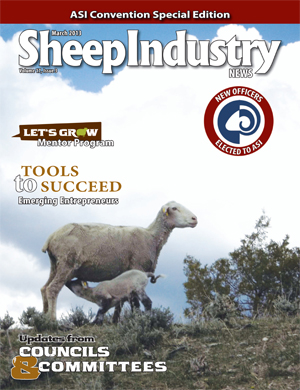
- March 2013
- Conaway Expresses Optimism on Farm Bill
- New Executive Board Members Elected to ASI
- President’s Notes
- ASI Elects New Officers
- I am Here to Work for You
- One Skin Type Can Not Make All Things
- Working to Reauthorize Livestock Mandatory Reporting
- Lamb Industry Assessment: Roadmap for the Industry
- Guns, Immigration, Fiscal Policies and Legacy Issues
- Re-Build Committee to Offer Funds for Mentor Program
- Bighorn Sheep and Disease Issues Cover at PERC Meeting
Re-Build Committee to Offer Funds for Mentor Program
By AMY TRINIDAD
Sheep Industry News Editor
(March 1, 2013) The Re-build the Sheep Inventory Committee kicked-off its second year of funding projects intended to support the Let’s Grow initiative at the annual convention. The emphasis of the Let’s Grow initiative this past year has been the development of a mentor program for new producers and to provide information to increase production efficiencies.
“In order to keep the industry’s infrastructure, we need more lamb and wool,” explains Clint Krebs, in his last meeting as chair of the committee due to his election of president.
“Time and time again we saw university officials support the Let’s Grow initiative when speaking in front of groups about how to increase profitability and be more efficient producers. With the downturn in market prices and nationwide drought, most producers could not increase breeding sheep but could be more efficient with the numbers they have. We need to promote more efficiency and be more profitable every year,” relays Peter Orwick, American Sheep Industry Association executive director.
In its initial year, 31 state associations participated in the ASI Mentor Program, which awarded states with a $1,000 grant to encourage and support new sheep producers. An array of activities was spearheaded and many states utilized their own funds as a cost-share program. Some of the activities included:
- the development of a mentor team to work with new producers in a group or one-on-one setting;
- funding for educational seminars with subject matters that are relevant to new producers; and
- funding to help support starter flock programs.
ASI developed a tool to assist with the mentor program, the Toolkit for New Sheep Producers, which consists of a number of production management tips, educational resources and the Sheep Production Handbook. Approximately 300 of the toolkits have been distributed over the past year.
The committee was encouraged with the use of these funds and again will offer a $1,000 grant to those states that have spent the full monies from last year and provided a synopsis of their activities to ASI. More information will be distributed to state association leaders soon regarding eligibility to participate in 2013. In addition, the committee has earmarked additional funds to award states that develop a matching-grant plan that goes beyond the original $1,000 grant. The committee designated April 1 as the deadline to submit proposals for the matching-grant program with funding distributed in May. For more information on this program, contact the ASI office at 303-771-3500 or mary@sheepusa.org .
A major funding program for the committee both last year and this fiscal year is the SheepSD project, a South Dakota State University Extension program that has been designed to help sheep producers enter and expand into the sheep industry. Since its launch mid-last year, a broad learning community of 29 operations called “Growing South Dakota Sheep Producers” and a core learning community consisting of 17 beginning sheep operations has been established. Those in the core learning community have committed to a three-year educational program designed to provide beginning ranchers with a curriculum that will equip them with the tools to make wise management decisions that will lead to economic, ecological and sociological sustainability and in turn contribute to ongoing agricultural production, land stewardship and rural community viability.
Other activities of this program within the last six months include:
- the establishment of a beginning sheep producer standing committee as part of the South Dakota Sheep Growers Association to develop leadership skills through promotion and education;
- establishing the Northern Plains Sheep Symposium in which members of the learning community and other producers from Montana, North Dakota, Wyoming and South Dakota attended;
- conducting a wool production and quality workshop at Center of the Nation Wool to teach proper shearing and wool handling techniques; and
- conducting a ewe management and late pregnancy workshop.
The group’s activities over the next year include monthly educational workshops, continued development of mentoring relationships, the implementation of ranch advisory teams, a lamb feedlot performance activity, a lamb 20/20 program on meat grading and fabrication, a production and marketing study trip to Chicago and again attending the Northern Plains Sheep Symposium.
Another program that was funded through the re-build committee in conjunction with the National Sheep Industry Improvement Center was a three-part webinar series hosted by Jay Parsons of Optimal Ag. Topics included the proper feeding of ewes during breeding and pregnancy, capitalizing on the mutual benefits of a mentoring relationship and parasite management. All of these webinars were recorded and are available for viewing at www.growourflock.org/resources . Parsons reported that, in addition to those who attended the webinars, a total of 1,300 hits have been made to the site hosting them.
To close the meeting, an announcement was made that Mike Corn, ASI secretary/treasurer, from New Mexico will be the new committee chair and that they were looking for new committee members.

